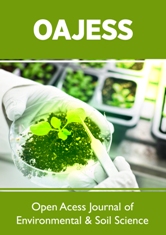
Lupine Publishers Group
Lupine Publishers
Menu
ISSN: 2641-6794
Editorial2641-6794 
Research and Review of Forest Ecological Security in the Yangtze River Economic Belt Volume 4 - Issue 4
Xu Tang*
- Department of Economics, Beijing Forestry University, China
Received: January 30, 2020; Published: February 06, 2020
Corresponding author: Xu Tang, Department of Economics, Beijing Forestry University, China
DOI: 10.32474/OAJESS.2020.04.000192
Editorial
The paper, the assessment of forest ecological security and
its determining indicators: A case study of the Yangtze River
Economic Belt in China, written by Dr. Xu Tang et al., focuses on
forest ecological security issues. Forest ecosystem is the largest
and the most important natural ecosystem in terrestrial ecosystem.
The forest ecosystem has multiple functions: it produces oxygen
to supply human beings and all kinds of animals and plants; it
absorbs carbon dioxide to reduce the earth’s greenhouse effect;
it provides various nutrition, food, and habitats for all kinds of
animals and plants to maintain biodiversity; it also helps to shield
against wind and sand, protects soil and water, and prevents rocky
desertification. Compared with other ecosystems such as wetlands,
deserts, and oceans, forest ecosystems have the most biological
species, the most complex structures, and the strongest ecological
benefits. However, along with the development of human society,
forests have been destroyed dramatically by human activities
making forests overwhelmed and forest ecosystems increasingly
fragile. Excessive deforestation, wasteland cultivation, and
overgrazing by humans have led to a continuous reduction in forest
area and forest volume. This decline will inevitably lead to serious
consequences such as the greenhouse effect, soil erosion, climate
anomalies, disappearance of endangered species, and ecological
imbalances. The continuous decline in the quantity and quality of
forests will negatively affect the health of the forest system in the
short term, and it will threaten the survival of humans and other
creatures in the long run; eventually, it will threaten the sustainable
development of human beings. Therefore, in this context, it is of
practical significance to establish an evaluation index system to
monitor the security of forest ecosystems.
Assessing the vulnerability of forest ecosystems can use the
concept of forest ecological security. Forest ecological security
refers to the integrity and health of the forest ecosystem under
human pressure, that is, the ability of forests to self-regulate
and self-repair, and it is generally measured by using the forest
ecological security index. A high forest ecological security index
shows a high level of integrity and health of the forest ecosystem and
a strong human capacity for sustainable development. Conversely,
A low forest ecological security index shows a weak ability of
forest ecosystems to ensure sustainable human development. The
evaluation of forest ecosystems must consider not only the forest
ecosystem itself, but also human activities. As human activities
are complex and changing, the forest ecological security index is
also considered to be changing dynamically. From the aspect of
spatial scale, different forest ecosystems in different places are
facing various threats; therefore, forest ecological security also has
regional characteristics.
In recent years, the high frequency of forest ecological security
incidents has gradually attracted people’s attention to forest
ecological security issues, but the concept of forest ecological
security is relatively new and corresponding researches are still in
preliminary stage. Existing researches on forest ecological security
mostly focus on human interference, fire, and other influencing
factors. However, few scholars have established comprehensive
evaluation index systems. In terms of research scope, most
researches focus on the national, provincial, and river basin level,
while literatures on forest ecological security index from the county
level are scarce. In terms of research methods, scholars mostly use
PSR models or system dynamics models to study ecological security.
In addition, ArcGIS is also widely used in evaluating ecological
security.
The paper, the assessment of forest ecological security and its
determining indicators: A case study of the Yangtze River Economic
Belt in China, takes the Yangtze River Economic Belt as the scope
of study. The paper measures the forest ecological security index
of 1086 districts and counties and analyzes the corresponding
influence factors. The Yangtze River is China’s largest river and
the third longest river in the world. The Yangtze River is one of
the regions which maintain most abundant water resources and
biodiversity in China. It provides a suitable environment for the local
people to live and develop. With these conditions, the Yangtze Rive Economic Belt was formed. Although Yangtze River Economic Belt
accounts for only one-fifth of the country’s area, its GDP accounts for
nearly half of the country’s total GDP. However, in recent decades,
with the over-exploitation by people, the vegetation on both sides
of the Yangtze River has gradually decreased and the forest has
gradually degraded, these have resulted that the forest volume per
unit area in the region is far below the national average. The scarce
forest resources have caused frequent natural disasters such as soil
erosion, drought and flooding in the region, which have seriously
affected the sustainable development of local people and society.
To reverse this trend, the Chinese government has successively
initiated the construction of the Yangtze River shelter-belt system
and plain greening projects; the government has implemented key
ecological projects such as natural forest protection, returning
farmland to forests, desertification control, wetland protection,
wildlife protection, and nature reserve construction. The latest
monitoring report shows that the decline of forest resources in the
region has been reversed, forest quality and structure have been
continuously optimized, the total area of wetlands has remained
stable, the expansion of decertified land areas has been curbed, and
rock desertification control is being actively promoted.
In order to comprehensively evaluate the degree of forest
ecological security in the Yangtze River Economic Belt, the research
group has undergone the first test, the second test, and the third
test with the support of the government. The whole research lasted
5 years .In the first test, 15 counties in five provinces were covered;
in the second test, all counties in five provinces were covered;
in the last test (the third test), all counties in 11 Provinces and
municipalities along the Yangtze River were covered. The difficulty
of data collection was increasing along with the expansion of the
experiment region. The process of data collection started from
2000 and ended at 2015. Due to the lack of data before 2010, this
paper only selects data collected from 2010 and 2015. In order
to collect data, the research team held data training meetings in
Wuhan, Nanchang, Nanjing, Chongqing, and Kunming to assign data
collection tasks. At the same time, in order to calculate the forest
ecological security index, the research team organized several
expert meetings which included forestry and ecology experts in
Beijing to finally determine the index system and index calculation
method.
Due to the difficulty of data collection, the research group
reduced the initially identified 32 indicators to 17 indicators. At the
same time, due to the different degrees of difference in the index
data, the index calculation method has also been adjusted from
the original entropy weight method to a comprehensive method
that places equal emphasis on the entropy weight method and
the expert method. The improvement of the index system and the
adjustment of the index calculation method have been recognized
by the expert group. In terms of field investigation, the object group
was divided into three groups, the data of which were surveyed
in 33 typical counties (3 typical districts and counties in each
province or municipality were selected) and a large amount of
first-hand information was obtained. On this basis, according to the
evaluation from the expert group, the calculation results obtained
by the research group are basically in line with the actual situation
of the forest. The index system and index calculation method
established by the research group is able to provide several useful
references for other ecological security studies.
In this paper, Xu Tang et al. first reviewed the research
development of forest ecological security, established a
comprehensive index evaluation system, and calculated the forest
ecological state index, the forest stress index, and forest ecological
security index of the Yangtze River Economic Belt by entropy
weight method, expert method, and geometric mean method.
This paper analyzes the distribution characteristics of the forest
ecological state index, pressure index, and comprehensive index
from the perspective of the whole region by using ArcGIS, and
then compares and analyzes the forest ecological security index
of the eight major tributaries from the perspective of the whole
tributaries. In addition, Xu Tang et al. also divided the areas with
lower forest ecological security index values into 5 categories:
Forest Quantity Lagged Problem Areas, Forest Quality Problem
Areas, Intense General Pressure Problem Areas, Intense Behavioral
Pressure Problem Areas, Comprehensive Lagged Problem Areas.
For each type of problem area, distribution range and basic features
are analyzed, and corresponding improvement suggestions are
proposed. Finally, Xu Tang et al. used the spatial lag model (SLM),
the spatial error model (SEM), and the ordinary least square (OLS)
method to analyze the influencing factors of the forest ecological
security index. The research found that: i) The lower reaches of
the Yangtze River Economic Belt are the most problematic area;
ii) Natural factors are the fundamental conditions for building
forest ecological security; iii) population structure positively
influences forest ecological security and Economic growth
negatively influences forest ecological security; iv) The proportion
of secondary industry negatively influences the forest ecological
security.
Although this paper has some shortcomings, it has established
a practical analysis framework for forest ecological security
assessment and the analysis of influencing factors. Subsequent
research can modify the evaluation indicators based on this
or increase influencing factors to improve the robustness and
interpretability of the model. In addition, the identification of
problem areas in this paper can serve as a reference for the forestry
department to take corresponding measures to improve the local
forest ecological security.
After studying the forest ecological security in the Yangtze
River Economic Belt, the research scope of this research group will
be expanded to all counties in the country. Therefore, the next goal
is to collect data in all provinces, municipalities and autonomous
regions in China to comprehensively analyze and assess the state
of forest ecological security in China . In addition, due to China’s
large population, low per capita natural resources, and greater
pressure on ecological protection, the Chinese government is
considering delineating ecological protection red lines to ensure
sustainable social and economic development. In this context, the
research group will conduct in-depth research on forest ecological
security and combine it with ecological carrying capacity to provide more scientific basis for the delineation of the ecological protection
red line. At the same time, due to the low efficiency of forest land
use, farmers and the government have less benefit from forestry,
so local governments are actively taking measures to improve the
efficiency of forest land use. To this end, the research group will
study the issues of forest protection and forest land use at a micro
level to better coordinate the relationship between humans and
natural resources.

Top Editors
-

Mark E Smith
Bio chemistry
University of Texas Medical Branch, USA -

Lawrence A Presley
Department of Criminal Justice
Liberty University, USA -

Thomas W Miller
Department of Psychiatry
University of Kentucky, USA -

Gjumrakch Aliev
Department of Medicine
Gally International Biomedical Research & Consulting LLC, USA -

Christopher Bryant
Department of Urbanisation and Agricultural
Montreal university, USA -

Robert William Frare
Oral & Maxillofacial Pathology
New York University, USA -

Rudolph Modesto Navari
Gastroenterology and Hepatology
University of Alabama, UK -

Andrew Hague
Department of Medicine
Universities of Bradford, UK -

George Gregory Buttigieg
Maltese College of Obstetrics and Gynaecology, Europe -

Chen-Hsiung Yeh
Oncology
Circulogene Theranostics, England -
.png)
Emilio Bucio-Carrillo
Radiation Chemistry
National University of Mexico, USA -
.jpg)
Casey J Grenier
Analytical Chemistry
Wentworth Institute of Technology, USA -
Hany Atalah
Minimally Invasive Surgery
Mercer University school of Medicine, USA -

Abu-Hussein Muhamad
Pediatric Dentistry
University of Athens , Greece

The annual scholar awards from Lupine Publishers honor a selected number Read More...




